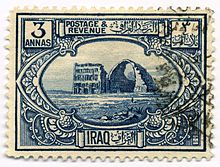Ctesiphon
- For the Spanish saint, see Ctesiphon of Vergium.
33°05′37″N 44°34′50″E / 33.09361°N 44.58056°E

Ctesiphon (Arabic: قطسيفون, Persian: تیسفون) was one of the great cities of the Persian Empire, located on the east bank of the Tigris.
Ctesiphon was an imperial capital of the Arsacids and of their successors, the Sassanids. Today, the ruins of Ctesiphon lie in Iraq, approximately 35 km south of the city of Baghdad. Ctesiphon is first mentioned in the Book of Ezra of the Old Testament as Kasfia/Casphia (a derivative of the ethnic name, Cas, and a cognate of Caspian and Qazvin). In the 6th century, Ctesiphon was the largest city in the world.[1]
The Latin name 'Ctesiphon' or 'Ctesifon' derives from Greek 'T(h)esifon' or 'Et(h)esifon', continuing in later Greek as 'Ktesiphon' (Κτησιφῶν). In Iranian sources of the Sassanid period it is attested in Manichean Parthian, in Sassanid Middle Persian and in Christian Sogdian as Pahlavi tyspwn, continuing in New Persian as 'Tisfun' (تيسفون). In medieval Arabic texts the name is usually 'Taysafun' (طيسفون) or 'Qataysfun' (قطيسفون), in Modern Arabic 'Madain', 'Maden' or 'Al-Mada'in ' (المدائن). "According to Yaqut [...], quoting Hamza, the original form was Tusfun or Tusfun, which was arabicized as Taysafun."[2]
Location

Ctesiphon is located approximately at Al-Mada'in, 20 miles (32 km) southeast of the modern city of Baghdad, Iraq, along the river Tigris. Ctesiphon measured 30 square kilometers (cf. the 13.7 square kilometers of 4th century imperial Rome). The only visible remain is the great arch Taq-i Kisra located in what is now the Iraqi town of Salman Pak.
History
Ctesiphon rose to prominence during the Parthian Empire in the first century BC, and was the seat of government for most of its rulers. The city was located near Seleucia, the Hellenistic capital. Strabo abundantly describes its foundation:

"In ancient times Babylon was the metropolis of Assyria; but now Seleuceia is the metropolis, I mean the Seleuceia on the Tigris, as it is called. Near by is situated a village called Ctesiphon, a large village. This village the kings of the Parthians were wont to make their winter residence, thus sparing the Seleuceians, in order that the Seleuceians might not be oppressed by having the Scythian folk or soldiery quartered amongst them. Because of the Parthian power, therefore, Ctesiphon is a city rather than a village; its size is such that it lodges a great number of people, and it has been equipped with buildings by the Parthians themselves; and it has been provided by the Parthians with wares for sale and with the arts that are pleasing to the Parthians; for the Parthian kings are accustomed to spend the winter there because of the salubrity of the air, but they summer at Ecbatana and in Hyrcania because of the prevalence of their ancient renown."
— Strabo XVI, 1, 16[3]
Because of its importance, Ctesiphon was a major military objective for the leaders of the Roman Empire in its eastern wars. The city was captured by Rome or by its successor state, the Byzantine Empire, five times in its history, three times in the second century alone. The emperor Trajan captured Ctesiphon in 116, but his successor Hadrian decided to willingly return Ctesiphon in 117 as part of a peace settlement. The Roman general Avidius Cassius captured Ctesiphon during another Parthian war in 164, but abandoned it when peace was concluded. In 197, the emperor Septimius Severus sacked Ctesiphon and carried off thousands of its inhabitants, whom he sold into slavery.
Late in the third century, after the Parthians had been supplanted by the Sassanids, the city again became a source of conflict with Rome. In 295, Galerius was defeated by the Persians outside the city. Humiliated, he returned a year later and won a tremendous victory which ended in the fourth and final capture of the city by a Roman army. He returned it to the Persian king Narses in exchange for Armenia. About 325 and again in 410 the city, or the Greek colony directly across the river, was the site of church councils for the Church of the East.
Emperor Julian was killed following a battle outside of the city walls in 363 during his war against Shapur II. Finally, in 627, the Byzantine Emperor Heraclius surrounded the city, the capital of the Sassanid Empire, leaving it after the Persians accepted his peace terms.
Ctesiphon fell to the Muslims during the Islamic conquest of Persia in 637 under the military command of Sa'ad Ibn Abi Waqqas during the caliphate of Umar. However, the general population was not harmed. Still, as political and economic fortune had passed elsewhere, the city went into a rapid decline, especially after the founding of the Abbasid capital at Baghdad in the 8th century and soon became a ghost town. It is believed to be the basis for the city of Isbanir in the Thousand and One Nights.
The ruins of Ctesiphon were the site of a major battle of World War I in November of 1915. The Ottoman Empire defeated troops of Britain attempting to capture Baghdad, and drove them back some 40 miles (64 km) before trapping the British force and compelling it to surrender.
Palaces of Ctesiphon
- See also: Sassanid architecture
The splendor of the imperial palace complex at Ctesiphon, to include Khosrau I of Persia's palace (Shâhigân-ǐ Sepid = the white palace, now almost totally ruined) and the great arch Taq-i Kisra, remain legendary. The Throne room—presumably under or behind the arch—was more than 36m (110ft) high. The massive barrel vault covered an area 24m (80ft) wide by 50m (160ft) long, and was the largest vault ever constructed in Persia.
References
- ^ Rosenberg, Matt T. (2007), Largest Cities Through History, New York: about.com
- ^ Kröger, Jens (1993), "Ctesiphon", Encyclopedia Iranica, vol. 6, Costa Mesa: Mazda
- ^ Strabo XVI, 1, 16

